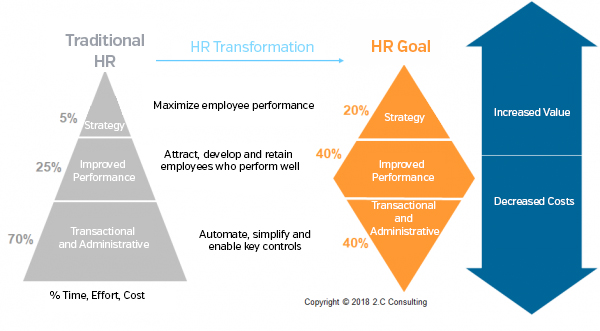By José Manuel Casado
According to various studies, less than 40 percent of HR departments are playing a key role to exploit digital technologies for better talent management. We still seem to be stuck with “more of the same”, as in in the customarily time-absorbing transactional tasks in these areas. Let’s remember what Jaz Fizz-End, the founder of Saratoga Institute, points out and possibly exaggerates, that 90 percent of the tasks done by HR are transactions and only 10 percent bring value.
My theory is that HR must radically transform and take advantage of the moment to ride the wave of digitalization and convert its threats into opportunities. This means shifting from the transactional approach to the strategic and tactical one.
That is why, as seen from the previous graph, the proposition of this platform is to encourage you to increase the value that HR brings to the company, while reducing costs.
Progress in technologies, process automation, mobility enabled by different types of devices, socialization via social networks, data analysis and its potential for forecasting, cloud-enabled connections, emerging artificial intelligence, the advent of augmented reality and new forms of organizing work and hire, relocation of production, and more—all these make us ponder what will happen to the traditional HR function. What should those in charge of such transactional management do? Where is HR heading?
Quo Vadis? Wither HR?
Just as with our Latin expression linked to Christianity, as in when Saint Peter was fleeing Rome and met the Lord who asked him, “Where are you going?”, HR management does not have to flee from its past, instead use it to propel the future. For that purpose, it must have a quite different agenda from the traditional one.
First of all, HR must expand their scope for management to share employee experiences and review the life cycle of the people in the company. To do so, HR will have to go from being an independent function to one with a holistic vision that encompasses various disciplines and cross functions. Eradicating the points of friction in the employee’s relationship with the company is an essential part of HR’s agenda to create an effective culture and employee engagement.
Second, HR must have know-how available from anywhere, at any time. With the growing skills gaps, especially digital ones, organizations must be able to quickly access critical competencies on demand when, how, and where they are needed. HR will have to transform to adapt to a more global world, match talent with tasks in various parts of the world, as well as support mobile workers across different geographical barriers. In such a scenario, HR will play a critical role in enabling the company to adapt to changing business conditions.
Third, HR must review the ways the company is organized to build a networked ecosystem. Agility and speed for problem-solving will play a fundamental role in the company, meanwhile traditional hierarchies must be replaced by teams that work more holacratically or in networks and with decision-making powers. This entails managing an extended and distributed workforce, and one of HR’s main missions will be to develop a value strategy to manage a broad, diverse workforce with different types of contracts. Robotics, artificial intelligence, sensors and cognitive computing have become pervasive as talent sharing economy emerges. Organizations can no longer consider all their workers as belonging to their workforce; we are beginning to talk about TaaS (Talent as a Service) as having a diverse workforce composed of in-house workers, workers from partnerships (alliances with other companies to do something together), others subcontracted for specific jobs , freelancers, knowledge communities (open sources), and more.
Moreover, this amalgam of workers is complemented by robots, machines and intelligent software. These trends will result in the redesign of almost all jobs and positions, as well as a new way of thinking about workforce planning and the nature of the work itself.
Fourth, collaboration must be encouraged, because knowledge workers need and demand collaboration from anywhere and any place. This radically transforms the organizational structure, hierarchies and job titles.
Fifth, just as the company, as a whole, is becoming digital, HR must strive to become a leader in the digital organization. That means going beyond digitalization platforms to create digital work environments with a digital workforce and implement technologies that change the way people work and interact on the job and outside. And above all, to manage cultural change so that people adopt new behaviours. This, dear reader, is the key challenge that I predict for talent management in the years to come.
Sixth, HR must quantify what they do and use the data on the people at work. This is something that is now beginning to be more important than ever. However, barely eight percent of companies are doing so. Analytics applied to people management has become an essential discipline for HR. As an example of such data usage, we can draw attention to how leading organizations use social networks, analytics, big data and cognitive tools to find and attract the best talent through their global brand, but the same can be done for all functions that make up the talent life cycle in the company.
Seventh, talent management must evolve and be based on human behavioural sciences. Advances in neurosciences (biology, neurology, psychology, sociology, engineering) provide knowledge that, when applied to the company, will improve management. Moreover, talent management must be steered towards a one-to-one kind of management, so it will have to treat each professional individually through personalization and delivering individual solutions.
As a conclusion for our particular “Quo Vadis”, we need to recommend HR becomes a performance consultant able to provide solutions to the business through provisioning a diverse, skilled and motivated workforce that can do its job in a digital flat environment, from any place and anytime, and supported by efficient use of new digital technologies to achieve the best business results. And yet HR should remember that often there is a tendency to overlook what is really important: the company culture. We must be convinced that the main challenge for organizations is not the digitalization of their businesses (this is the vehicle), but ultimately the goal is the transformation of their culture, i.e., for people to do other things in a different way. The guru of the digital economy, Don Tapscott, put it this way, “Technology may open doors, but it can’t force people to go through them”, or as I regularly say, “We may have the fastest car, yet we may still be stuck same traffic jam”.







